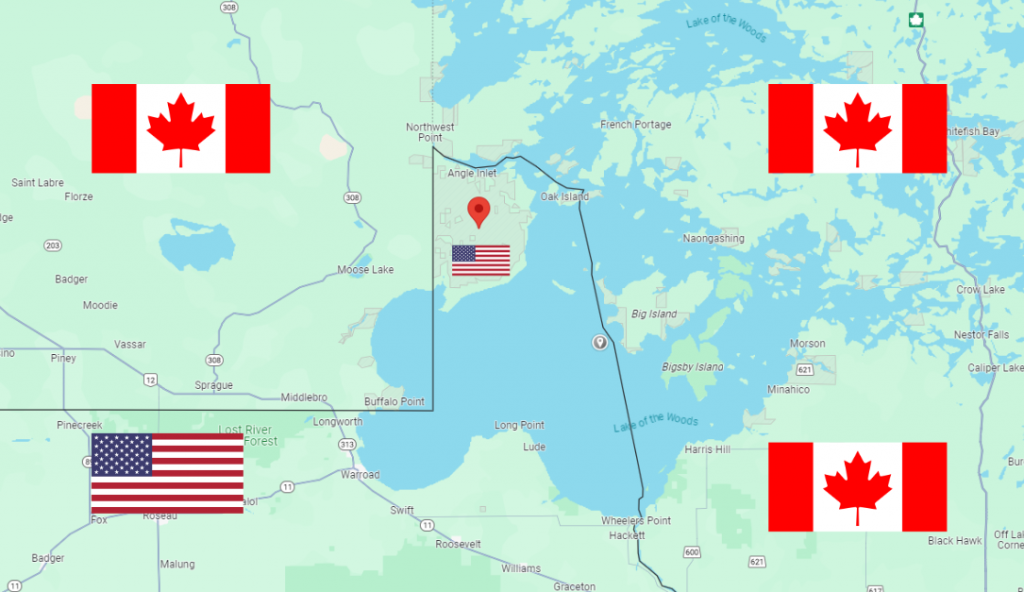The American Enclave That Pretended to Want to Join Canada
There are, as you probably know, fifty states in the United States. Two of them — Alaska and Hawaii — are disconnected from the rest; the remaining ones (and Washington, D.C.) make up what is often called the “contiguous 48 states.” But as it turns out, these 48 states aren’t entirely contiguous.
Let’s start with a map.

Pictured above is a Google Maps screenshot of the American/Canadian border around where Minnesota meets Manitoba and Ontario, with flags added (by me) to help you see which country is where. (If you want the original, flag-free map, click here.) That thicker black line is the international border, and you’ll note that it doesn’t quite work right. In the middle of the map is a small enclave — indicated by the red marker and the smaller American flag — that’s within the borders of the United States but, quite clearly, isn’t connected to the rest of the U.S. by land. That’s called the Northwest Angle, and it sits on the northwest corner of what’s known as the Lake of the Woods. If you live in the Northwest Angle, you’re an American — but to get to the rest of America (by car, at least), you’ll need to drive through Canada.
The Northwest Angle is a weird quirk of bad geography dating back to the American Revolution. The short version is that when American and British negotiators determined the boundaries of the United States after the Revolutionary War, they used a map (this one) that was very good but, alas, imperfect. The Lake of the Woods was believed to be an oval, but it’s actually not, and the northwest corner sits a lot further north than the late 1700s border drawers believed. As a result, this little piece of land that really should be Canadian is most definitely American.
But that almost changed in the late 1990s — all because of some fish.
The Lake of the Woods has a high population of walleye, a fish the BBC called “a succulent, flaky white fish revered by Minnesotans.” (The “revered” part is hardly an understatement; about a two-hour drive from the Northwest Angle — through Canada, of course — is a 40-foot-long, two-ton fiberglass walleye statue.) And in 1998, Ontario — the Canadian province that governs most of the Lake of the Woods — decided to restrict walleye fishing in the lake. The Chicago Tribune explains: “In the guise of conserving supposedly dwindling walleye stocks, Ontario declared fishermen from Minnesota resorts and American day-trippers would not be allowed to keep any walleye caught in Canada at all. Only Ontario residents and people who stayed at Ontario-based resorts could keep as many as six fish.” If you lived or visited that tiny piece of America nestled within Canada? No fish for you.
This was a big deal. As CBS News observed, “the sprawling, chilly waters of Lake of the Woods offer some of the best walleye fishing in all of North America” and the Angle attracts many American visitors who “put a hook in the water and then go home.” (Douglas Adams would approve.) No walleye fishing effectively crushed the already limited economy of the Angle, and the sixty or so people who lived there needed a solution. Their idea? Leave the United States. Or pretend to, at least.
People from the Angle met with their Member of Congress at the time, Representative Collin Peterson, to see what could be done. Peterson told them that under the terms of the North American Free Trade Agreement (better known as NAFTA), the United States and Canada had previously established a way to review such matters in an expedited fashion. The people of the Angle just needed a way to motivate the American government into action. They asked Peterson to introduce a constitutional amendment granting the Angle the right to secede from the United States and join Canada. As one resident told the Tribune, Peterson “scratched his head for a while and said it might cost him a little political mileage, but he’d go ahead and do it. And by golly, he did. Not everyone introduces a constitutional amendment. This was the first article of secession since the Civil War.”
The ploy worked. According to the BBC, the “dispute was resolved by Canada rescinding the fishing laws and the US dropping the fees for the Canadian National Railway; the two countries reached an agreement on fishing limits and licensing.” The Northwest Angle remained in the United States, and only the walleyes were worse off in the end.
Bonus fact: If you enter or leave the Northwest Angle and cross into (or out of) Canada, yes, you have to pass through customs. But it would be maddeningly inefficient to staff such a border crossing, so the U.S. and Canada came up with a simpler solution: a booth on the side of the road with some videophones. The booth, seen here, isn’t much to look at — it’s just a tiny shack. If you cross the border there, you’re expected to call the customs agent for the country you’re entering, make any necessary declarations, and wait for approval to continue. Per various reports, almost everyone follows the rules.
From the Archives: Scrambled City: A town that’s partially in Belgium, partially in the Netherlands, and ultimately, is a hot mess.
